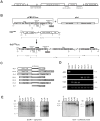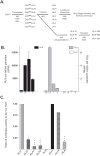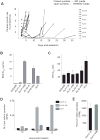A var gene promoter implicated in severe malaria nucleates silencing and is regulated by 3' untranslated region and intronic cis-elements
- PMID: 19463825
- PMCID: PMC2744600
- DOI: 10.1016/j.ijpara.2009.05.001
A var gene promoter implicated in severe malaria nucleates silencing and is regulated by 3' untranslated region and intronic cis-elements
Abstract
Questions surround the mechanism of mutually exclusive expression by which Plasmodium falciparum mediates activation and silencing of var genes. These encode PfEMP1 proteins, which function as cytoadherent and immunomodulatory molecules at the surface of parasitised erythrocytes. Current evidence suggests that promoter silencing by var introns might play a key role in var gene regulation. To evaluate the impact of cis-acting regulatory regions on var silencing, we generated P. falciparum lines in which luciferase was placed under the control of an UpsA var promoter. By utilising the Bxb1 integrase system, these reporter cassettes were targeted to a genomic region that was not in apposition to var subtelomeric domains. This eliminated possible effects from surrounding telomeric elements and removed the variability inherent in episomal systems. Studies with highly synchronised parasites revealed that the UpsA element possessed minimal activity in comparison with a heterologous (hrp3) promoter. This may result from the integrated UpsA promoter being largely silenced by the neighbouring cg6 promoter. Our analyses also revealed that the DownsA 3' untranslated region further decreased the luciferase activity from both cassettes, whereas the var A intron repressed the UpsA promoter specifically. By applying multivariate analysis over the entire cell cycle, we confirmed the significance of these cis-elements and found the parasite stage to be the major factor regulating UpsA-promoter activity. Additionally, we observed that the UpsA promoter was capable of nucleating reversible silencing that spread to a downstream promoter. We believe these studies are the first to analyse promoter activity of Group A var genes, which have been implicated in severe malaria, and support the model that var introns can further suppress var expression. These data also suggest an important suppressive role for the DownsA terminator. Our findings imply the existence of multiple levels of var gene regulation in addition to intrinsic promoter-dependent silencing.
Figures





Similar articles
-
Insulator-like pairing elements regulate silencing and mutually exclusive expression in the malaria parasite Plasmodium falciparum.Proc Natl Acad Sci U S A. 2012 Dec 26;109(52):E3678-86. doi: 10.1073/pnas.1214572109. Epub 2012 Nov 29. Proc Natl Acad Sci U S A. 2012. PMID: 23197831 Free PMC article.
-
Exonuclease-mediated degradation of nascent RNA silences genes linked to severe malaria.Nature. 2014 Sep 18;513(7518):431-5. doi: 10.1038/nature13468. Epub 2014 Jun 29. Nature. 2014. PMID: 25043062
-
Strict pairing of var promoters and introns is required for var gene silencing in the malaria parasite Plasmodium falciparum.J Biol Chem. 2006 Apr 14;281(15):9942-52. doi: 10.1074/jbc.M513067200. Epub 2006 Feb 2. J Biol Chem. 2006. PMID: 16455655 Free PMC article.
-
Antigenic variation in Plasmodium falciparum.Annu Rev Microbiol. 2008;62:445-70. doi: 10.1146/annurev.micro.61.080706.093134. Annu Rev Microbiol. 2008. PMID: 18785843 Review.
-
Mutually exclusive var gene expression in the malaria parasite: multiple layers of regulation.Trends Parasitol. 2008 Oct;24(10):455-61. doi: 10.1016/j.pt.2008.07.005. Epub 2008 Sep 2. Trends Parasitol. 2008. PMID: 18771955 Review.
Cited by
-
Enlightening the malaria parasite life cycle: bioluminescent Plasmodium in fundamental and applied research.Front Microbiol. 2015 May 11;6:391. doi: 10.3389/fmicb.2015.00391. eCollection 2015. Front Microbiol. 2015. PMID: 26029172 Free PMC article. Review.
-
Characterization of the unusual bidirectional ves promoters driving VESA1 expression and associated with antigenic variation in Babesia bovis.Eukaryot Cell. 2012 Mar;11(3):260-9. doi: 10.1128/EC.05318-11. Epub 2012 Jan 27. Eukaryot Cell. 2012. PMID: 22286091 Free PMC article.
-
Role of cis-regulatory elements on the ring-specific hrp3 promoter in the human parasite Plasmodium falciparum.Parasitol Res. 2010 Mar;106(4):833-45. doi: 10.1007/s00436-010-1738-9. Epub 2010 Feb 3. Parasitol Res. 2010. PMID: 20127361
-
Identification of a role for the PfEMP1 semi-conserved head structure in protein trafficking to the surface of Plasmodium falciparum infected red blood cells.Cell Microbiol. 2010 Oct;12(10):1446-62. doi: 10.1111/j.1462-5822.2010.01481.x. Cell Microbiol. 2010. PMID: 20438573 Free PMC article.
-
Analysis of the molecular mechanisms governing the stage-specific expression of a prototypical housekeeping gene during intraerythrocytic development of P. falciparum.J Mol Biol. 2011 Apr 29;408(2):205-21. doi: 10.1016/j.jmb.2011.02.043. Epub 2011 Feb 24. J Mol Biol. 2011. PMID: 21354176 Free PMC article.
References
-
- Andrews KT, Pirrit LA, Przyborski JM, Sanchez CP, Sterkers Y, Ricken S, Wickert H, Lepolard C, Avril M, Scherf A, Gysin J, Lanzer M. Recovery of adhesion to chondroitin-4-sulphate in Plasmodium falciparum varCSA disruption mutants by antigenically similar PfEMP1 variants. Mol Microbiol. 2003;49:655–669. - PubMed
-
- Barnwell JW. Cytoadherence and sequestration in falciparum malaria. Exp Parasitol. 1989;69:407–412. - PubMed
-
- Baruch DI, Pasloske BL, Singh HB, Bi X, Ma XC, Feldman M, Taraschi TF, Howard RJ. Cloning the P. falciparum gene encoding PfEMP1, a malarial variant antigen and adherence receptor on the surface of parasitized human erythrocytes. Cell. 1995;82:77–87. - PubMed
-
- Biggs BA, Anders RF, Dillon HE, Davern KM, Martin M, Petersen C, Brown GV. Adherence of infected erythrocytes to venular endothelium selects for antigenic variants of Plasmodium falciparum. J Immunol. 1992;149:2047–2054. - PubMed
Publication types
MeSH terms
Substances
Grants and funding
LinkOut - more resources
Full Text Sources
Medical

